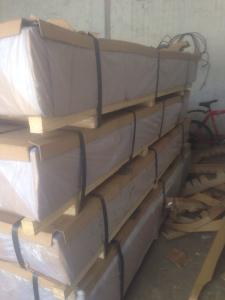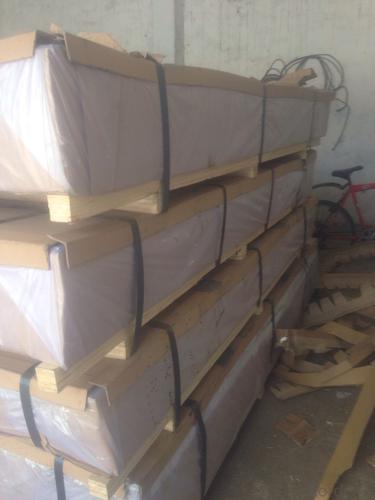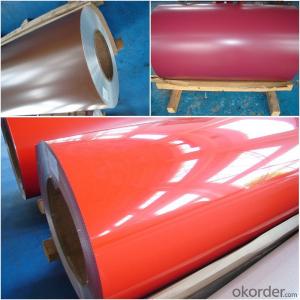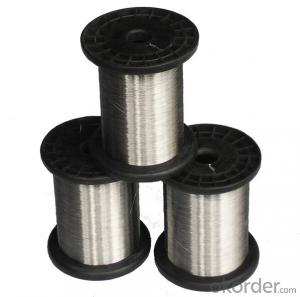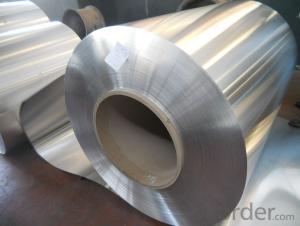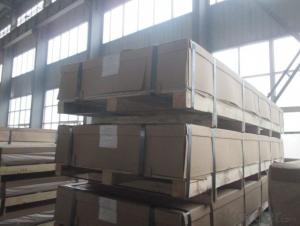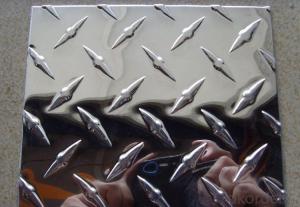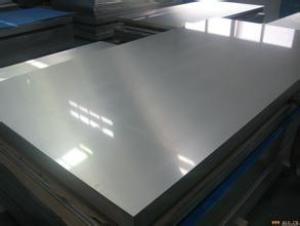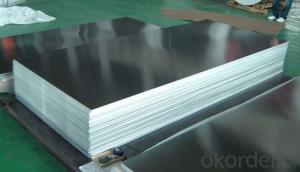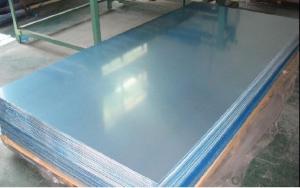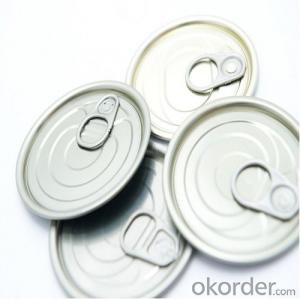Thin Aluminum Diamond Plate Sheets - Aluminium Finish Sheet with Best Price in Our Warehouse
- Loading Port:
- Shanghai
- Payment Terms:
- TT OR LC
- Min Order Qty:
- 2 m.t.
- Supply Capability:
- 7000 m.t./month
OKorder Service Pledge
OKorder Financial Service
You Might Also Like
Specification
1.Structure of Product Description
cold rolled aluinum composit panel and also the hot rolled aluminum sheet are all widely used in the field of are both widely used int xactly Alloy number are as follows: 1000 series, etc.
1050,1060,1100, 2024,5052,5754,5083,6061,6063,8011, etc.
The temper is include H14, H22, H24, H44,etc.
2. Main features of the product
a. best price.
c. Shortest service.
3. Image.
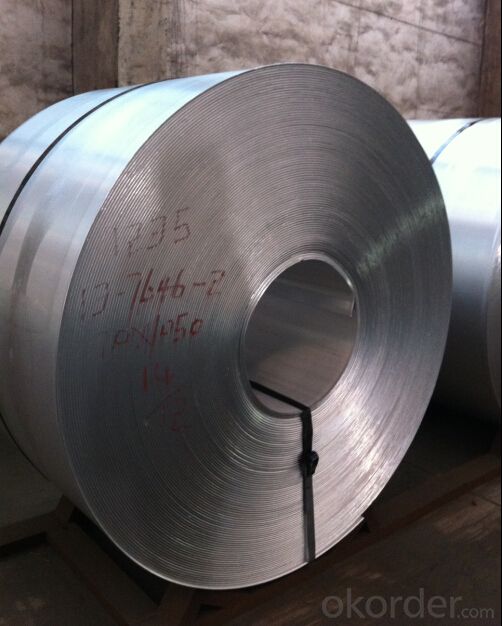
4. Product detailed sizes:
1000mm*2000mm,1250mm*2500mm,1500mm*3000mm, etc.
5. FAQ:
What is the quality standard?
---Usually our standard is GB3880-2006 or others.
What is the width range?
---It is from 500mm to 2500mm, etc.
What is the length range:
---It is from 800mm to 6000mm, etc.
What is the MOQ for yproducts yet?
---Normally it is around 11 tons/each size.
How many tons did you export in one year?
---Normally it is und 30000 tons totally.
Where is your client from?
---Normally itfrom UAE, Saudi Arabia, England,Turkey,Japan, etc.
What is your mainly products?
---Normally theyminum sheet,big-5-bar aluminium checkered sheet,small-5-bar aluminium mirror finish aluminium sheet, aluminum casting coil, etc.
- Q: This question asks about the various types of aluminum sheets that are commonly used for roofing purposes, including their specific applications and characteristics.
- <p>Aluminum sheets used for roofing come in various types, each with unique properties and applications. The main types include: 1) Corrugated Aluminum Sheets: Known for their strength and durability, these are often used in commercial and industrial roofing due to their ability to withstand harsh weather conditions. 2) Standing Seam Aluminum Sheets: These provide a sleek, clean look and are favored for their water-resistant properties, making them ideal for residential and architectural applications. 3) Flat Aluminum Sheets: Offer a smooth surface finish and are used where a uniform appearance is desired. 4) Perforated Aluminum Sheets: These have small holes that allow for ventilation, reducing heat build-up and are used in areas requiring natural light and air circulation. 5) Embossed Aluminum Sheets: With a textured surface, they provide added rigidity and are used in both residential and commercial settings for their aesthetic appeal. Each type is chosen based on the specific needs of the roofing project, such as design, weather resistance, and longevity.</p>
- Q: Are aluminum sheets fire-resistant?
- Yes, aluminum sheets are fire-resistant.
- Q: What does exterior wall imitate aluminium paint have? Imitate aluminium plate paint is fluorocarbon paint?
- The exterior walls are painted with aluminium and plastic panels, and only fluorocarbon metal paint is used. The fluorine content determines the service life;The construction technology of fluorocarbon metal paint is relatively complex, and the price is more expensive, generally including the construction is roughly equivalent to more than half the price point to use aluminum plate;
- Q: What specific conditions or regulations must be met when using aluminum sheets in commercial construction?
- <p>Yes, there are special requirements for using aluminum sheets in commercial buildings. These include adherence to building codes and standards for fire resistance, structural integrity, and weather resistance. Aluminum sheets must meet specific thickness and strength requirements depending on the application. They also need to comply with environmental regulations regarding sustainability and recyclability. Additionally, for aesthetic purposes, the finish and color of the aluminum sheets should be in line with architectural design guidelines. It's crucial to consult with architects, engineers, and local building authorities to ensure all requirements are met.</p>
- Q: Are aluminum sheets suitable for decorative purposes?
- Yes, aluminum sheets are suitable for decorative purposes. They are lightweight, durable, and versatile, making them ideal for various decorative applications such as wall panels, signage, furniture accents, and more. Additionally, aluminum sheets can be easily cut, shaped, and finished to achieve the desired decorative effect, making them a popular choice among designers and architects.
- Q: What are the different bending methods for aluminum sheets?
- Aluminum sheets can be bent using different methods, each with its own advantages and limitations. Various bending techniques for aluminum sheets include: 1. Air Bending: By utilizing a punch and die, a bend is formed in the aluminum sheet without direct contact. Compressed air is employed to exert force on the sheet, resulting in the desired bend. Air bending is a versatile method that allows for a range of bend angles and radii. 2. Bottom Bending: This method involves clamping the aluminum sheet between a V-shaped die and a flat die. A punch is then used to press the sheet into the V-shaped die, creating the desired bend. Bottom bending is suitable for achieving sharp bends with small radii. 3. Coining: Precise and crisp bends are formed by applying high pressure to the aluminum sheet between a punch and a die. Coined bends exhibit minimal springback. However, this method requires specialized equipment and is typically utilized for high-volume production. 4. Roll Bending: By passing the aluminum sheet between a set of rollers, it is gradually bent into the desired shape. Roll bending is commonly employed for creating cylindrical or conical shapes. This technique can achieve large radii and is suitable for thicker aluminum sheets. 5. Press Brake Bending: This commonly used method employs a hydraulic or mechanical press brake to create bends in aluminum sheets. The sheet is clamped between a punch and a die, and the press brake applies force to create the bend. Press brake bending offers flexibility in terms of bend angles and radii. It is important to consider various factors such as the desired bend angle, radius, material thickness, and specific application requirements when selecting a bending method.
- Q: Are aluminum sheets easy to work with?
- Yes, aluminum sheets are generally easy to work with. Aluminum is a lightweight and malleable metal, which makes it easier to cut, shape, and manipulate compared to other metals. It can be easily bent, formed, and welded, allowing for various fabrication techniques. Additionally, aluminum sheets have good corrosion resistance, which further adds to their ease of use. Whether it is for constructing lightweight structures, fabricating parts, or creating intricate designs, aluminum sheets provide versatility and convenience in many applications.
- Q: just bought a hobart handler 140 (already love it), and was just wondering on what gas to use for aluminum. my welder will be set up for mild steel (75% argon 25% CO2). it would be nice to be able to use this mix with aluminum as well, as it would be easy to just switch spools of wire, but the manual says to use a 100% argon mix when welding with aluminum. will the 25% CO2 make a difference welding aluminum?
- Get the kit which will have new drive wheels and the liner, and get the right gas, and don't plan on using any thin aluminum, I was never able to have fine enough control on my machine to get it to work well on anything less than 1/8 material. Also, you will probably buildup too much heat and burn through if you try to go far, weld about 1 at a time and let the material cool. Your machine and mine are just barely on the edge of being capable of doing this. It is nearly impossible to dial it in to a reliable point.
- Q: Hi, I'm new here. Yoroshigu.I'm trying to make flash paper for magic tricks.To do that I have to make flash powder but in my location I can hardly find ingredients. Not to think about buying. Usually, I wait for a season and buy firecrackers. Then, I take the power and soak them into the paper and dry. This works but not so flash. Burned more likely.So, I wonder if I take aluminium oxide from aluminium oxide sandpaper and mix with powder from firecracker would produce a brighter flash than firecracker power alone?anyone know please share.
- it will make your penis larger because of the fact it is going to construction up scar tissue. In time you may have a extensive thick cuck and the ladies persons will like it. additionally, you will get such thick skin on it which you are going to have little or no sensation, which ability you may carry on very very nearly without end. the ladies will initiate speaking approximately you and different ladies will want to be sure for themselves. So those physique builders can loaf around with sweaty mens with their toddler oil and their spandex. you would be scoring with a distinctive chick everynight.
- Q: Are aluminum sheets suitable for chemical filtration applications?
- Yes, aluminum sheets are suitable for chemical filtration applications. Aluminum is known for its excellent corrosion resistance and durability, making it a reliable choice for chemical filtration systems. Aluminum sheets can effectively filter out impurities and contaminants in various chemical processes, including separating solids from liquids and removing harmful substances. Additionally, aluminum sheets can withstand high temperatures and pressures, making them suitable for a wide range of chemical filtration applications.
Send your message to us
Thin Aluminum Diamond Plate Sheets - Aluminium Finish Sheet with Best Price in Our Warehouse
- Loading Port:
- Shanghai
- Payment Terms:
- TT OR LC
- Min Order Qty:
- 2 m.t.
- Supply Capability:
- 7000 m.t./month
OKorder Service Pledge
OKorder Financial Service
Similar products
Hot products
Hot Searches
Related keywords
